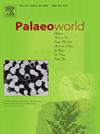Middle to late Maastrichtian planktonic foraminifera from the Gongzha section in Dingri area, southern Xizang, China
IF 1.7
3区 地球科学
Q2 PALEONTOLOGY
引用次数: 0
Abstract
The Late Cretaceous strata in the Dingri area of southern Xizang represent one of the best-preserved marine deposits of the Tethys Ocean. In this study, we focus on the biostratigraphy and systematic paleontology of middle–late Maastrichtian planktonic foraminifera, sampled from a series of continuous outcrops in the upper part of the Zongshan Formation at the Gongzha section in the Dingri area. A total of 25 species belonging to 12 genera are recorded. These foraminifera were identified as belonging to the CF4 Zone and CF3 Zone based on the first appearances of Racemiguembelina fructicosa and Psuedoguembelina hariaensis, respectively. According to the correlation to the international planktonic foraminifera zones, the age interval from the R. fructicosa Zone to the Psg. hariaensis Zone spans middle–late Maastrichtian. This newly identified fauna offers valuable chronological data for the paleontology and biostratigraphy of the Late Cretaceous planktonic foraminifera in the Dingri area of southern Xizang and for the study of the paleoenvironment changes in Late Cretaceous.
西藏南部定日地区贡扎剖面马斯特里赫特中晚期浮游有孔虫
西藏南部定日地区晚白垩世地层是特提斯洋保存最完好的海相沉积之一。本文以定日地区公扎剖面宗山组上段连续露头为研究对象,对中晚期马岛浮游有孔虫进行了生物地层学和系统古生物学研究。共记录到12属25种。根据首次出现的Racemiguembelina fructicosa和Psuedoguembelina hariensis,这些有孔虫分别属于CF4区和CF3区。根据与国际浮游有孔虫带的相关性,从果螨带到Psg的年龄间隔。哈里亚氏带横跨马斯特里赫特中晚期。这一新发现的动物群为西藏定日地区晚白垩世浮游有孔虫的古生物学和生物地层学以及研究晚白垩世古环境变化提供了有价值的年代学资料。
本文章由计算机程序翻译,如有差异,请以英文原文为准。
求助全文
约1分钟内获得全文
求助全文
来源期刊

Palaeoworld
PALEONTOLOGY-
CiteScore
4.00
自引率
5.90%
发文量
95
期刊介绍:
Palaeoworld is a peer-reviewed quarterly journal dedicated to the study of past life and its environment. We encourage submission of original manuscripts on all aspects of palaeontology and stratigraphy, comparisons of regional and global data in time and space, and results generated by interdisciplinary investigations in related fields. Some issues will be devoted entirely to a special theme whereas others will be composed of contributed articles. Palaeoworld is dedicated to serving a broad spectrum of geoscientists and palaeobiologists as well as serving as a resource for students in fields as diverse as palaeobiology, evolutionary biology, taxonomy and phylogeny, geobiology, historical geology, and palaeoenvironment.
Palaeoworld publishes original articles in the following areas:
•Phylogeny and taxonomic studies of all fossil groups
•Biostratigraphy, chemostratigraphy, chronostratigraphy
•Palaeoecology, palaeoenvironment and global changes throughout Earth history
•Tempo and mode of biological evolution
•Biological events in Earth history (e.g., extinctions, radiations)
•Ecosystem evolution
•Geobiology and molecular palaeobiology
•Palaeontological and stratigraphic methods
•Interdisciplinary studies focusing on fossils and strata
 求助内容:
求助内容: 应助结果提醒方式:
应助结果提醒方式:


